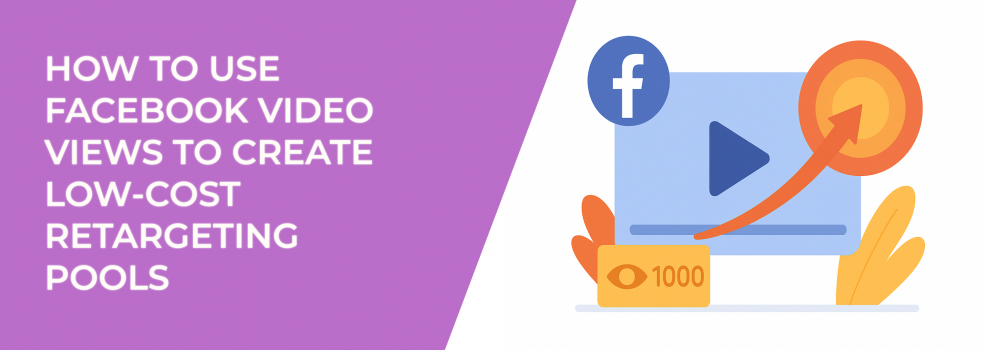When Meta began tightening its targeting options, many advertisers feared the end of efficient prospecting. Interest-based audiences shrank. Third-party data faded. Custom audiences became more difficult to scale. But one overlooked source of cheap, high-quality intent signals remains: Facebook video views.
And if you’re not building retargeting pools based on video viewers yet, you’re leaving money and conversions on the table.
Why Video Viewers Are an Untapped Goldmine
Let’s start with something most advertisers agree on: retargeting works. But not all retargeting pools are created equal. Website visitors, email subscribers, and engaged fans are powerful, but expensive to acquire. And in a world where iOS privacy updates have made pixel tracking unreliable, many of those signals are incomplete.
Since iOS privacy changes disrupted how Meta tracks users off-platform, many advertisers are shifting to native signals. We go deeper into those strategies in this article.
Video views, on the other hand, are 100% native to Meta. That means the platform tracks them accurately, with no reliance on third-party cookies or pixel events. You can retarget based on exactly how long someone watched a video — 3 seconds, 10 seconds, 25%, 50%, and so on.
More importantly, video views are cheap. A short, engaging video can generate hundreds of thousands of views for a fraction of the cost you'd pay for clicks or conversions. Even better? Many of those viewers are qualified leads — you just haven't followed up with them yet.
So the real question is: Why wouldn’t you use video to build your warm audience?
The Strategy: Build Interest First, Then Retarget
Think of this as a two-step funnel. First, you cast a wide net. Then you reel in the ones who showed real intent.
Step 1: Run a low-cost video ad campaign to cold audiences.
This isn’t about making a sale right away. It’s about capturing attention. Use a short, punchy video that introduces your product, service, or offer — think under 60 seconds. Show the product in use, solve a specific pain point, or share a testimonial. The goal is engagement, not conversion.
Target broadly. Try a lookalike, a saved audience, or even just general interest categories. Your CPMs will stay low because video content often gets prioritized in Meta’s ad auctions.
Step 2: Create custom audiences based on video views.
Inside Ads Manager, create audiences of people who watched at least 25% or 50% of your video. These users didn’t just scroll past. They stopped, they watched, and they signaled interest.
Then retarget them. But now, your message should change. Offer something specific. A discount. A lead magnet. A strong product demo. Now you’re talking to a warm audience.
This works especially well for small businesses with limited budgets. Why? Because you're not paying premium prices to reach “warm” audiences — you're creating your own, affordably.
If you need a refresher on how to technically set up these retargeting audiences, check out our step-by-step guide on how to set up Facebook retargeting.
What Makes a Video Worth Watching?
Your video doesn’t have to be a cinematic masterpiece. But it does need to check a few boxes:
-
Hook fast: The first 3 seconds matter more than the rest. Start with movement, a bold statement, or a question.
-
Make it mobile-first: Most views will be on smartphones, so go vertical or square. Keep text large. Use captions.
-
Lead with value: Instead of listing features, show what problem your product solves. Make it relatable.
-
Keep it short: Under 30–60 seconds is ideal. You want to spark interest, not explain everything.
Try this: imagine your ideal customer is scrolling quickly, half-distracted. What would make them stop? Start your video there.
Need help making thumb-stopping videos that still fit your budget? Here’s our guide to creating high-impact Facebook video ads without breaking the bank.
Don’t Just Retarget — Segment
Once you've built an audience of video viewers, you can get even more strategic. Not all viewers are equal.
You can segment audiences based on how much of the video they watched. Someone who watched 75% is probably more interested than someone who only stuck around for 3 seconds. Use that to guide your creative.
Here’s how you might break it down:
-
75% viewers. These are highly engaged. Retarget them with:
-
A product demo,
-
A limited-time discount,
-
A testimonial carousel,
-
A strong call-to-action like “Buy now” or “Start free trial”.
-
-
50% viewers. They’re interested, but maybe not sold yet. Try:
-
An intro offer or bundle,
-
A quick behind-the-scenes video,
-
A feature breakdown.
-
-
10-second or 25% viewers. These folks need more warming up. Keep it light:
-
A blog post (“How to choose the right skincare product”),
-
A short explainer,
-
A soft CTA like “Learn more”.
-
-
Clicked + Viewed. Create an audience of people who watched your video and clicked through but didn’t convert. These are strong leads. Retarget them with:
-
A time-sensitive offer,
-
A case study,
-
A reminder that something’s waiting in their cart.
-
This kind of segmentation helps your retargeting feel personalized. More relevant ads usually mean cheaper results.
A Few Advanced Tips That Can Stretch Your Budget
-
Use video views across campaigns: You can build video view audiences once, then reuse them across multiple campaigns — lead gen, sales, even page engagement.
-
Create video sequences: Show different videos over time. Video A to cold leads. Video B to 25% viewers. Video C to 75% viewers. This builds story and familiarity.
-
Test different view thresholds: Don’t just settle on 50%. Try 25%, 10 seconds, even 3 seconds. Different businesses find success with different levels of intent.
-
Exclude recent viewers from top-of-funnel campaigns: Save budget by excluding anyone who’s already watched your video. No sense paying twice for the same person.
These small adjustments compound over time. For budget-conscious advertisers, that can make all the difference.
What About Attribution?
One question that comes up often: How do I know video views are actually leading to sales?
Fair point. Video view campaigns themselves aren’t designed for conversions — they’re meant to feed your funnel. But if your retargeting is dialed in, you’ll start seeing results within a few days of running the second-step campaigns.
Use Meta’s attribution tools to track conversions from your retargeting audience. You can also split test to compare: Run a retargeting campaign with video-viewers versus one with no warm audience. Watch the cost per result. The difference is usually clear.
Final Thoughts
If you’re frustrated by rising CPMs, weaker targeting, or poor match rates from pixel data, video view retargeting might be the simplest fix you haven’t tried yet.
You don’t need a giant budget. You don’t need a viral video. You just need a smart structure: build attention, then retarget those who actually paid attention.
Think of it as a funnel made of intent. And with the right creative, timing, and follow-up, that funnel converts.

